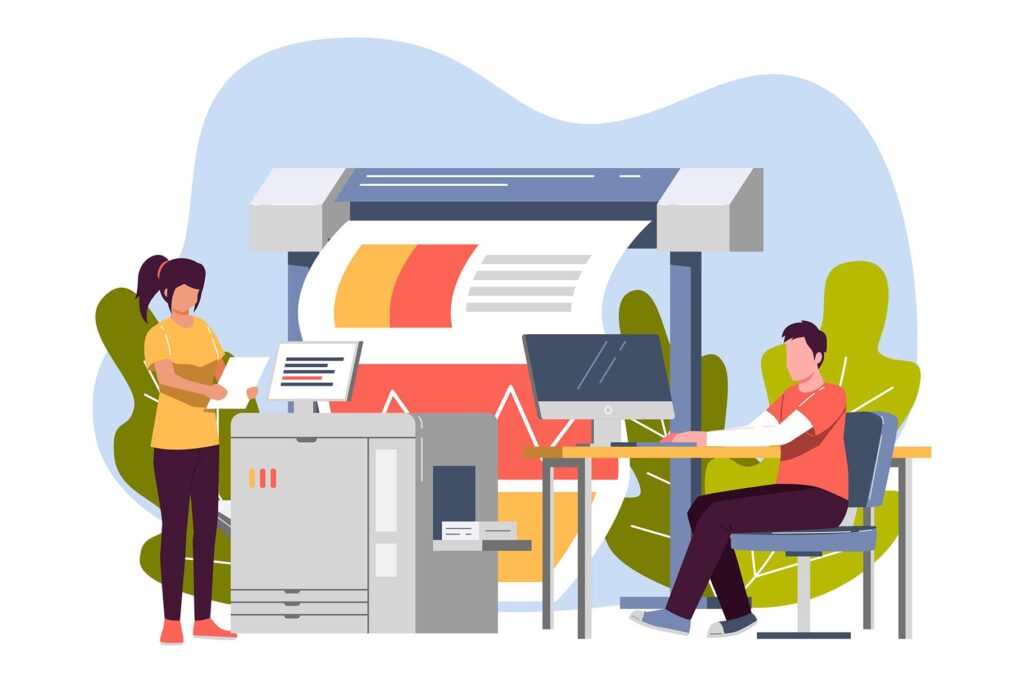Typography is a key component of modern graphic design. It has been around for centuries and will continue to be an important part of the visual language we use every day.
Typography has evolved over time, and the way we use it has changed. It is a constantly evolving form of communication.
In this article, We’ll explore how typography has evolved over time and what it means for you as a designer or consumer.
The Importance of Typography in Graphic Design

A graphic designer’s job is to create effective visual communication, and the use of typography plays a major role in this process.
Typography is the art and technique of arranging type to make written language legible, readable, and appealing when displayed.
It involves choosing typefaces (fonts) for their aesthetic qualities; arranging words so that they are visually balanced on the page; adjusting letter spacing; and selecting appropriate fonts for specific purposes such as headlines or body text.
The importance of typography in graphic design cannot be overemphasized because it determines how your message will be perceived by your audience.
Typography conveys meaning through its form, style, and arrangement on the page. In fact, according to Communication Arts Magazine, “Typography isn’t just about typeface choice–it’s also about color palette selection and layout.”
Early Origins of Typography
The origins of typography can be traced back to the invention of movable type by Johannes Gutenberg in 1450. Before this, books were hand-written in illuminated manuscripts by monks and scribes.
The word comes from the Greek words “typos” (printing type) and “graphos” (writing). The history of typography can be traced back to the early 1500s when Johannes Gutenberg invented movable type, a process that allowed for the mass production of books.
The first printed book was the Gutenberg Bible. It is estimated that it took Gutenberg and his team of workers three years to produce this first book.
The process of producing the book was extremely labor-intensive, requiring printers to carve individual letters from wood blocks and then assemble them into words and sentences by hand.
Calligraphy: The Art of Beautiful Writing
The art of calligraphy is a form of writing that uses a broad-edged pen or brush to create artistic letterforms.
Calligraphy is an ancient art form that originated in China and spread to Europe through the Arab world. It was widely practiced during the Middle Ages when monks used it to decorate manuscripts.
Today, calligraphy is used for decorative purposes in graphic design, advertising, and other forms of commercial art.
Calligraphy is an art form that involves the use of calligraphy pens and brush pens. It’s also a form of visual art that involves the use of writing and stylized lettering.
Calligraphy can be practiced by hand, using pen and ink on paper or parchment, or it can be done digitally on a computer using software such as Adobe Illustrator or CorelDRAW.
Calligraphy has been used as a means of communication throughout history by many societies around the world; however, its popularity has waned since the invention of printing presses during the Industrial Revolution in Europe during the 17th century CE (Common Era).
Calligraphy pens are available in various sizes ranging from fine point tips all way up to 1mm wide tips! These allow you to create different types of styles when writing out text such as italic lettering which gives off an elegant look when used correctly!
Also, read Role of Typography in Logo Design (The Ultimate Guide)
Gutenberg and the Printing Revolution

The Gutenberg printing press is widely considered to be the first mass-produced printing press, and it made use of movable type. The first book printed on this revolutionary machine was the Bible in 1455.
The invention of the press allowed for books to be produced much more quickly than they could be hand-copied by scribes or monks.
Before this invention, books were written on parchment (animal skin) or vellum (taken from calfskin), which had to be stretched out flat before being written on using ink pens made from quills or reeds.
The invention of the printing press helped to fuel the European Renaissance. The Gutenberg Bible was the first book ever printed from movable type, and it was one of many books printed by Johannes Gutenberg in his lifetime.
The Evolution of Typeface Design: From Metal Type to Modern Fonts
The history of typeface design is an exciting journey that has shaped the way we communicate today. As with any new technology, there are always improvements to be made and adjustments to be made based on user feedback.
The evolution of typography can be traced back to its origins in metal typesetting during the Renaissance period, which was followed by advancements in printing technology during the Industrial Revolution.
The next step towards modern fonts came when advancements were made in photoengraving processes; this allowed designers to create more detailed typefaces with subtle curves and serifs (the little decorations on letters).
This process also allowed for much larger sizes than what could have been done before due to increased precision in cutting each letter out from metal blocks or wood blocks used previously.
In the early 1900s, a German-type designer named Beatrice Warde began writing about what she considered to be the ideal characteristics of modern fonts.
She believed there should be a “harmonious balance of its components,” and that each letter should have a “distinctive personality.” She also said that the serifs on a font shouldn’t be too thick or thin, but rather just right.
Impact of the Industrial Revolution on Typography
The Industrial Revolution is a period from the 18th to 19th centuries when major changes in agriculture, manufacturing, mining, and transport affected socioeconomic conditions.
The steam engine was invented by James Watt in 1769; it was improved upon by others and became an integral part of the industrial revolution.
The use of steam power led to increased efficiency in many industries as well as transportation systems such as railways.
The impact of this technology on typography was significant: new typefaces were designed based on their ability to be easily read under various lighting conditions; printing presses became faster and more accessible, with fonts that could be adjusted according to width rather than height alone.
The invention of the typewriter and its widespread use throughout the 19th century was another major development that changed typography.
The typewriter allowed professional writers to produce works far more quickly than they had before, and it also changed the way in which handwritten documents were produced.
With the invention of the typewriter, people were able to write faster and more efficiently than ever before. The typewriter also made it possible for documents to be produced professionally and quickly by non-professionals.
The invention of computers in the mid-20th century changed typography once again. In addition to allowing people to typeset their own documents more easily, computers allowed them also to produce documents containing custom typefaces, sizes, and styles that couldn’t be printed on a traditional printing press.
Rise of Advertising and its Influence on Typographic Design

Advertising has always relied on typography to communicate its messages, but over time this practice has changed.
While some aspects of advertising have remained the same (such as using bold headlines), others have evolved greatly (like using white space).
Today’s advertisers are experimenting with new ways to use typography in their advertisements that will influence how we think about it for years to come.
The use of typography in advertising has changed dramatically over time. Early advertisements were often very simple, with a few lines of text and an image printed on paper.
As technology advanced, so did the ways we could advertise products and services. In the 1920s, advertisers began to use bold headlines to attract attention and communicate their message quickly.
In the 1940s and 1950s, advertisers began to experiment with more subtle methods of advertising. They used white space and illustrations to draw attention to their product.
It wasn’t until the 1960s when advertisers began experimenting with new ways to use typography in their advertisements that will influence how we think about it for years to come.
And in today’s era, we are seeing more and more designers getting involved in the advertising process. They are creating ads that rely heavily on typography, rather than just visuals.
Digital Revolution: Typography in the Age of Computers
The digital revolution has changed the way we design and use typography. The ease of access to fonts has allowed us to experiment with different typefaces, styles, and sizes.
Digital fonts are also more flexible than their analog counterparts because they can be used for multiple languages and can be enlarged or reduced in scale as needed.
For example, if you’re designing a poster for an event at your local museum that will be printed in both English and Spanish (or any other language), then it would make sense to use a font that supports both languages instead of creating two separate versions–one English version and one Spanish version–of your artwork.
The same goes for web design: If there are multiple languages on your website (and there probably are), then using one font instead of several will make it easier for everyone involved!
You may also like 20+ Best Decorative Fonts for Spectacular Designs (2023)
The Role of Typography in Branding and Visual Identity
Typography plays an important role in establishing your brand’s visual identity. The choice of typeface you select should be consistent with the overall look and feel of your company, as well as its message.
The best way to do this is by choosing a typeface that reflects the personality or values of your business but also works well with its industry or niche market.
For example, if you own an organic food store that sells products sourced locally from small farms around town then it would make sense for you to use fonts like Courier New which were originally designed for typewriters; this would reflect both its rustic roots as well as give off an earthy vibe (and who doesn’t love organic vegetables?).
On the other hand, if you’re selling luxury watches online then serifed fonts like Garamond may be more appropriate given their sophistication compared with sans serifs such as Helvetica Neue Black (which would give off more modern vibes).
Balancing Tradition and Innovation in Typographic Design
The importance of traditional typography is to be able to use it as a base for your designs. The more you understand how different typefaces work and how they look when combined with each other, the better you will be at creating effective and engaging designs.
Innovation is what makes a design stand out. The more you understand the rules of traditional typography and how they can be broken, the better your designs will become.
If you want to create something different and unique, then playing around with these rules will help you avoid falling into the trap of clichéd design that everyone has seen before.
Typography can be a powerful tool for creating engaging and effective designs—but only if you know the rules. If you have a thorough understanding of traditional typographic principles, your work will tend to be better.
That said, it’s important to remember that these rules are not set in stone. They are guidelines that can be broken if you understand how they work and when it’s appropriate to do so.
Future of Typography in Graphic Design
With technology advancing at an incredible pace, our understanding of typography will continue to evolve. As designers, we have the unique opportunity to play a role in this evolution by experimenting with new ways of using type and pushing the boundaries of traditional rules.
As we become more comfortable with technology, we will also be able to rely less on it. We are already seeing this trend in the work of many designers who have been inspired by traditional typographic principles.
This is the future of typography, and we are all fortunate to be living and working at a time when it is still so young. We have learned that typography is not just a tool for communication, it’s also an art form. We are always looking for new ways to express ourselves with type, and this constant search will continue far into the future.
Role of Artificial Intelligence (AI) in Typography Design

Artificial intelligence is transforming many fields, including typography design. With it, designers are getting new tools and possibilities for more innovative typographic compositions.
AI algorithms can analyze vast amounts of data and patterns, enabling designers to create new typefaces that were once unimaginable.
One of the key contributions of artificial intelligence in typography design is that it automates font creation.
AI can streamline the process of designing a new font by learning from existing ones and generating one based on specific parameters.
This makes it possible to try out different styles and variations without having to redo every single one.
AI-powered tools can analyze typographic elements like letterforms, spacing, and proportions. These tools also offer real-time feedback and suggestions for improvement—helping designers create better designs faster.
Well-crafted typefaces make the text easier to read and look more beautiful.
AI algorithms can recommend font combinations that complement each other by analyzing vast typographic databases, considering various factors like contrast and mood.
Conclusion
In the end, typography is a powerful tool that can help convey a message and create an emotional response in your audience. As with any other medium, it’s important to keep up with trends and innovations in order to stay relevant as a designer. But at its core, typography will always remain an essential part of graphic design because it’s such an integral part of our lives!
Recommended reading: The Importance of Choosing the Right Typeface
FAQs
How has typography evolved?
Typography has evolved over time as a means of communication. With the advent of new technologies and media, we have seen an increase in the use of typography for branding, advertising, and marketing purposes.
What is typography in graphic design?
Typography is the art of using typefaces to communicate an idea or message. It can be used in any medium, from print to textiles and even architecture.
How did typography first start?
Typography first started when Johannes Gutenberg invented the printing press in 1455. This allowed books to be mass-produced, which helped spread knowledge across Europe.
How do you create typography in graphic design?
Typography is the way that information is presented in a graphic design. The most common kind of typography is text, but there are also other types of typography, such as logos or sketches.
4 thoughts on “Evolution of Typography in Graphic Design (The Ultimate Guide)”